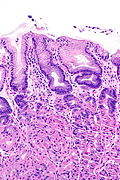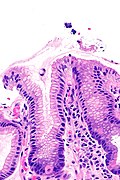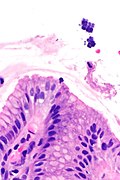Sarcina

Micrograph showing Sarcina. H&E stain. (WC/Librepath)
Sarcina organisms are seen in the gastrointestinal tract.
General
- Probably a commensal organism.[1]
- Gram positive coccus.[2]
- Uncommonly seen.
- Associated with gastroparesis,[1] as may be seen in diabetes mellitus.
Described complications:[1]
- Gastric perforation.
- Emphysematous gastritis.
Notes:
- Sarcina ventriculi = Gram-positive organism.[1]
Gross
Features:
- Erythema.
- +/-Gastric ulcer.
- +/-Retained food.
Microscopic
Features:[3]
- Small essentially spherical micro-organisms.
- Each micro-organism 1.8-3 micrometres - purple on H&E stain.
- Arranged in clusters of 4, 8 or more - classically in a tetrad - key feature.
DDx:
- Micrococcus - form larger clusters.[3]
Images
Case 1
www
See also
References
- ↑ 1.0 1.1 1.2 1.3 1.4 Ratuapli, SK.; Lam-Himlin, DM.; Heigh, RI. (2013). "Sarcina ventriculi of the stomach: a case report.". World J Gastroenterol 19 (14): 2282-5. doi:10.3748/wjg.v19.i14.2282. PMID 23599657.
- ↑ "Pathogenic Sarcina in urine". BMJ Case Rep 2016. 2016. doi:10.1136/bcr-2016-216991. PMID 27737866.
- ↑ 3.0 3.1 Lam-Himlin, D.; Tsiatis, AC.; Montgomery, E.; Pai, RK.; Brown, JA.; Razavi, M.; Lamps, L.; Eshleman, JR. et al. (Nov 2011). "Sarcina organisms in the gastrointestinal tract: a clinicopathologic and molecular study.". Am J Surg Pathol 35 (11): 1700-5. doi:10.1097/PAS.0b013e31822911e6. PMID 21997690.






